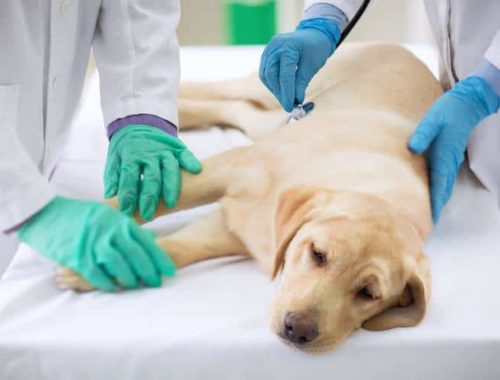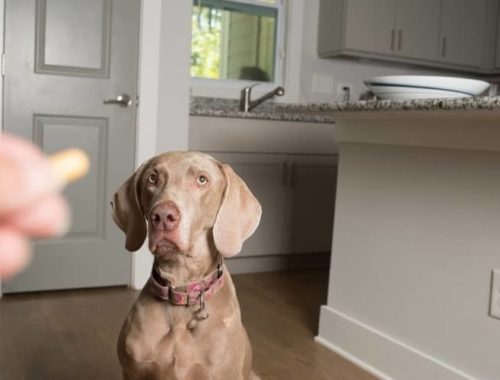It’s 2:00 am and you are outside with your sick pup, again, for the third time since bedtime, when you notice bright red blood in his stool. As if being awakened repeatedly to the sound of vomiting and diarrhea was not difficult enough, you now feel a little panicked about this recent development.
Worried, you search the internet and find that there are many causes of blood in a dog’s stool. Hopefully, this article will demystify this for you and help you determine when to seek immediate care and when it is safe to wait.
Blood in Dog Stool: A Quick Assessment
First, you will want to determine if the red color is actually blood. Ask yourself the following questions:
- Did my dog eat a nonfood item that is red, such as crayons or red lip balm?
- Was my child eating a cupcake with red icing and shared with my dog?
Human food colored with a copious amount of food coloring, or nonfood items that contain dyes, can color the contents of the gastrointestinal tract as they move through. In most cases, this is harmless. Ask your veterinarian if the suspected ingestion poses any health risks.
Second, look under the hood, er, the tail. An infection near the anus, such as a ruptured anal sac, can cause blood to appear in the stool. Injury to the sensitive rectal tissues can also lead to streaks of fresh blood. While these causes need to be addressed, there is no reason for immediate action in the middle of the night.
Third, ask yourself the following questions:
- Is the stool normal in consistency (firm, not loose)?
- Is my dog acting normally (eating with normal energy level)?
If the answer to these questions is yes, you can wait until the next day to pursue medical intervention.
Causes of Blood in Stool
Viral and bacterial illness– Dogs are prone to developing irritation in their lower gastrointestinal tract for a variety of reasons. When accompanied by loose stool, anorexia and/or vomiting, an infection is likely the culprit.
Many viral and bacterial agents can cause illness and lead to bloody stool. If untreated, the symptoms can progress to a syndrome called hemorrhagic gastroenteritis (characterized by copious amounts of bloody, loose stool). This condition usually requires hospitalization, so early intervention of gastrointestinal symptoms is helpful to prevent progression.
If you have a sick puppy with blood in the stool, you must ACT FAST. Parvovirus is common, especially in unvaccinated pups, and can be rapidly fatal is not treated.
Intestinal parasites– Some intestinal parasites can cause bleeding in the lower intestinal tract. Fortunately, heartworm preventatives deworm monthly and will help control infection. But, even dogs that receive regular preventatives can become infected between doses. If there are parasites, your veterinarian will be able to help you devise a treatment schedule.
Foreign body– Dogs will eat just about anything. Nonfood items can become lodged in the GI tract, causing both straining and loose stool. The subsequent damage to the tract, both from the lodged item and the straining, can cause blood to be present. Diarrhea can be noted even with a foreign body, so don’t let the presence of loose stool fool you, especially if you are missing socks.
Immune-mediated thrombocytopenia– This disease is relatively uncommon but can be catastrophic if not caught early. Something triggers the body to attack and consume platelets and the lack of clotting ability can lead to active bleeding in many parts of the body, including the gastrointestinal tract. In some cases, the red blood cells are also attacked, causing anemia. Take a quick peek at your dog’s gum color. If it appears pale instead of pink, immediate medical care should be pursued.
Food allergies– Many dogs become allergic to proteins in food as they age. If the allergy is severe and the offending ingredient is consumed, colitis (inflammation in the lower gastrointestinal tract) can result. This inflammation can lead to damage to the lining of the tract and subsequent blood in the stool. If the symptom resolves and recurs, this may be the cause and a logical course of action determined by your veterinarian should be followed. Do not try to address this on your own, as some diets that are commercially available are not appropriate and may cause more harm.
Blood in a dog’s stool is just a symptom, and the underlying cause needs to be identified and addressed. When accompanied by diarrhea and lethargy, immediate veterinary care should be pursued. If your dog is acting normally, with a good appetite and energy level, it is generally safe to wait until the next day but keep a close eye on behavior, appetite, and stool consistency.
Is your dog pooping blood and mucus? Find out what the cause could be and how to treat blood and mucus in your dog’s stool.
Feature Image Credit: SasaStock, Shutterstock






























